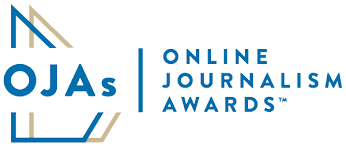 I’ve been teaching undergraduate online journalism courses for a decade. It’s a non-stop quest to keep up with emerging technology, publishing platforms, storytelling techniques, and news outlets — and to figure out how best to integrate them into a traditional classroom.
I’ve been teaching undergraduate online journalism courses for a decade. It’s a non-stop quest to keep up with emerging technology, publishing platforms, storytelling techniques, and news outlets — and to figure out how best to integrate them into a traditional classroom.
As part of this effort, I began using the Online Journalism Awards as the one of the primary “texts” in my digital reporting course.
I’ve found it a simple, yet effective, way to help keep my course content current and to expand my students’ news diets.
Here is what I do.
Each summer, I start building my syllabus around the foundational elements of the course: ethics, how to find a story and pitch it, interviewing, and techniques for capturing sound, photos and video. I assemble my readings from textbooks and online articles and tutorials for equipment and editing software. I also outline the basic parameters and goals of the reporting assignments.
The finalists for the Online Journalism Awards are announced each year in mid-August. On the first day of the semester, I introduce the awards and immediately get students clicking, watching and discussing the entries. And each week for the rest of the semester, I connect specific entries or categories from the OJAs to my class material.
For each of my students’ reporting assignment, I use OJA finalists as examples. I urge my students to try to imitate them in their own work.
When my students cover a news event, we talk about how to approach their stories in a “digital first” manner.
When my students prepare to do video interviews, we look for the most effective examples of shooting, editing and publishing video for mobile.
For their explanatory reporting assignment, students explore how a range of publications like Grist, Oregon Public Radio and Vox provide background on current events.
When they work in teams on a topical multimedia feature, I show them the award-winning work from students at other universities.
My students have also discovered new publishing tools for creating maps, animated videos, and graphics by digging into the OJAs. They are often surprised that they have access to the same tools as professionals.
Most significantly, my students see that even small or local publications with limited staff and resources — the kinds of places they are most likely to land their first jobs — can do innovative and groundbreaking work.
